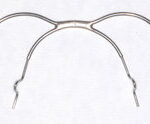Protective headgear is widely considered a necessity for sparring in boxing and martial sports in general. Even amateur wrestling requires a form of headgear to protect the ears. The classic boxing headgear consisted of a heavily padded disc that surrounded the forehead, temples, and back of the head, ear protectors, and lightly padded straps running across the cheek to close with a clasp under the chin. This kind of headgear is still in use today, but has been supplemented by a variety of products with more features. Choosing the right headgear is a matter of matching features to needs, and this guide will help either a beginning amateur or a seasoned coach do exactly that.
Standard Headgear
As previously stated, this is the classic staple of boxing training. All other versions of headgear are essentially built on it. It offers good protection from concussion to the cranium, especially around the temples (which are thin) and the back of the head (which is vulnerable in knockdowns and other falls). The ears are well-protected. The padded cheek straps are basically an afterthought. Indeed, early versions did not have padded cheek straps.
The main consumer of this kind of headgear should be the amateur boxer. It is just like the headgear worn in competition, and nothing provides better preparation than using the same gear used in the real thing. For pros and those just looking for some sparring, however, another piece of headgear would probably be better.
Standard Headgear with Cheek Protectors
This headgear builds on the standard, offering full pads to protect the cheeks. These actually do not cushion blows very well, but they do offer good protection from cuts. This is why this should be the normal headgear of either a professional fighter, or anyone who just wants to do a little sparring.
Mexican Headgear
Mexican headgear takes the cheek protectors and carries them a couple of steps further. The cheek protectors are now full-sized pads that enclose the entire face, leaving only openings for the eyes, nose, jaw and mouth. It is practically a padded ancient Greek helmet. A person wearing this is almost immune to cuts and black eyes, and receives a little protection for the nose. Only the mouth and chin are fully exposed.
Full-Face Headgear
This takes the Standard Headgear with Cheek Protectors, and adds a lightly-padded chin strap. From a practical point of view, the padding under the chin is meaningless. Fighters are better off with either Mexican or Facesaver Headgear.
Facesaver Headgear
This piece of headgear has a padded bar running across the front of the face. This makes it very hard for punches to make full, clean contact with the face. Anyone who needs to preserve their looks or is a bit glove shy should take a serious look at this headgear. However, hard shots that land squarely on the bar have a tendency to give the head and neck a good shaking.
Caged Headgear
This is the most protection a set of headgear can offer. Punches simply cannot make direct contract with the head or face. In fact, it is so good that it is hard to see what a fighter can really learn from sparring while wearing it. This headgear goes too far in protection, and should only be chosen by the truly glove shy. Anyone else would need to abandon it shortly after. Coaches might find a good use for it with fighters who are healing a cut, broken nose, or shiner. It will allow the fighter to keep sparring while they are healing and with almost no risk of re-injury.
The two best makers of headgear are Ringside and Reyes, and both product lines are available on the Ringside website.
Sources: personal experience.



